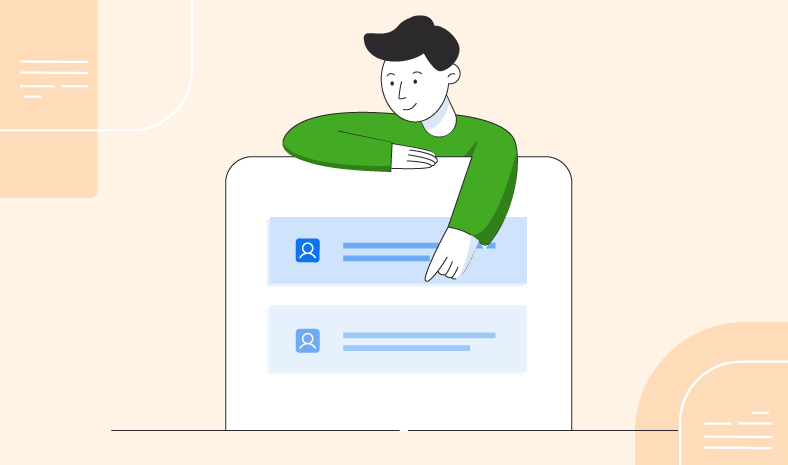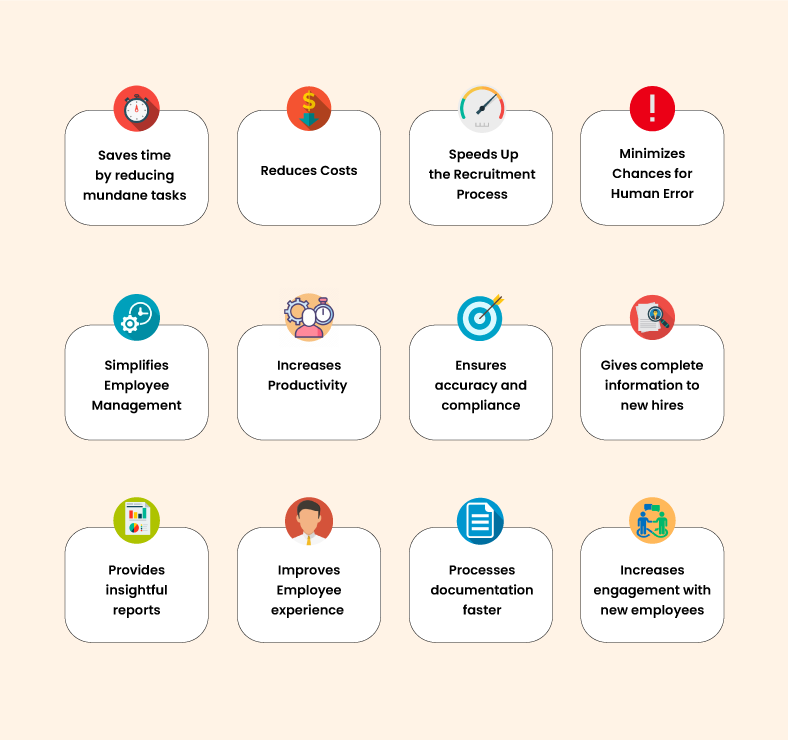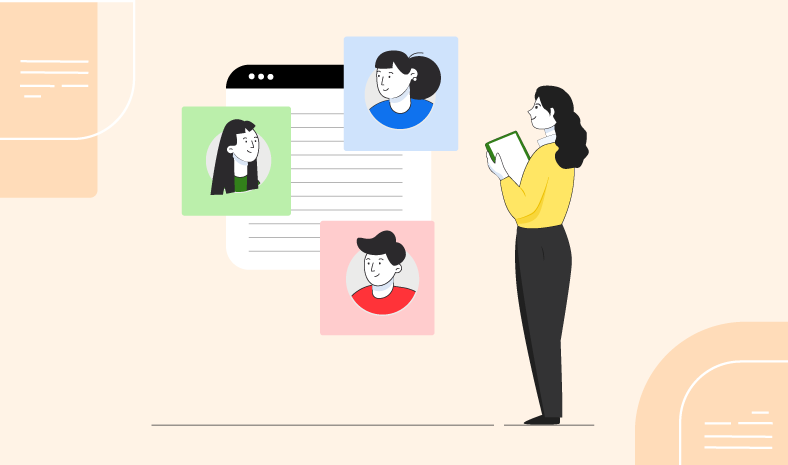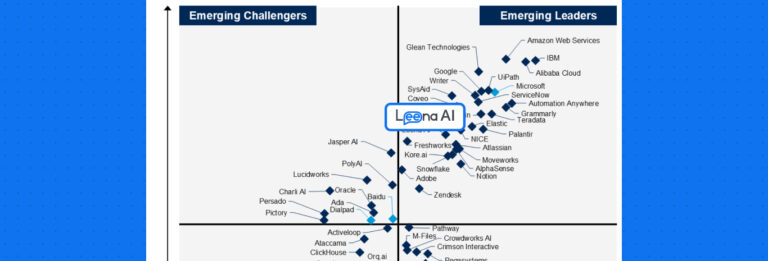The importance of a well-structured onboarding process to positively influence your new hires cannot be overemphasized. Providing an extraordinary onboarding experience to new employees is critical to establishing your image as a preferred employer.
But as the war for talent continues, the HR department of most growing companies is compelled to process bulk recruitments. However, manual recruitment and onboarding for thousands of candidates are hectic, error-prone, and time-consuming tasks.
In today’s fast-paced and competitive talent acquisition landscape, an automated onboarding process is crucial for giving new hires a hassle-free experience. Apart from increasing employee satisfaction, automating the process has multifaceted benefits.
Read through this blog to uncover how automating the onboarding process benefits your organization and plays an essential role in its growth.
But first, what is the difference between manual and automated onboarding?

Essentially, there are two kinds of employee onboarding – mainstream manual and new-age digital onboarding. Traditionally, the manual approach to handling critical onboarding tasks has been prevalent in many companies. However, the process becomes document heavy and lengthy.
Some of its attributes are
- confusion in interdepartmental communication
- time-consuming and prone to human error
- fragmented organization and administration of the processes
- overwhelming and stressful for both parties involved
Now that time has changed, and the traditional approach does not cut the mark anymore, automating the onboarding process has become indispensable. Some of the characteristics of automated onboarding include:
- Faster resolution of issues faced by employees
- Reduces time and costs by cutting down on manual work
- More opportunities to create human connections
- Track the progress of the program
What is onboarding automation?
The automated onboarding process refers to leveraging technology such as artificial intelligence for streamlining and structuring each step of the onboarding process. HRs can set onboarding workflows or even use predefined ones to get the tasks done automatically, like sending new hires company details, laptops, and goodies, asking them to upload documents, assigning them a buddy, and more. It saves HRs time and leaves a good impression on new hires.
What are the benefits of automating the employee onboarding process?
The advantages of automating onboarding lie in simplifying the work of the HR department in an organization and simultaneously providing new hires with a seamless experience. Following are the other benefits of automating the onboarding process:

Saves time by reducing mundane tasks
Onboarding involves a plethora of repetitive and mundane administrative work. The HR department has to get all necessary documents, devices, and credentials ready, introduce the new hires to their respective team, make them aware of the culture and policies, and monitor them while they complete their tasks. Naturally, manually handling all this is a daunting and time-consuming task.
But with the automated employee onboarding process, your HR department does not have to worry about completing mundane tasks.
From seamless documentation to answering queries, AI-driven onboarding software executes all the repetitive but necessary operations with no error or delay. This way, HR professionals can save a sea of time and invest it in more strategic employee engagement planning.
Reduces costs
Onboarding and training a new employee manually takes time and resources. HR and IT teams spend hours entering employee data, setting up equipment, and providing access to the company systems. All this increases expenditure, turning employee onboarding into a rather pricey practice.
But if companies invest in AI-driven onboarding software, it limits the number of employees involved in the process, diversifying the available resources into different administrative tasks.
Employee onboarding automation benefits also include reducing the training cost for new hires without compromising on training quality. It increases the retention rate, saving the company a fortune that they might spend on filling sudden vacancies.
Speeds up the recruitment process
The competition in talent acquisition is at its all-time high. In such a situation, it is essential to make onboarding as efficient as possible. According to a report, 40% of new hires mentioned that the response from HR takes too long.
It is because of completing the onboarding formalities manually. This makes the whole process lengthier and reduces the overall motivation of new hires. Miscommunication may also cause delays in the onboarding process.
On the other hand, an automated onboarding process enables HRs to complete all the formalities and operations on time without putting too much pressure on the candidate. With interactive AI-powered onboarding software, you can prevent miscommunication and provide prompt responses to the candidates, speeding up the recruitment process.
Minimizes chances for human error
Employee onboarding is a sensitive and multifaceted process. When HRs repeat the same steps for each candidate, it can be prone to error. Since the process involves a lot of data processing and administration work, these errors might lead to documentation discrepancies and may hamper employee experience.
With automation, your administrative tasks are handled electronically. It eliminates the chances of typos and miscalculations. Moreover, the data does not go through many hands for processing and is stored accurately.
Simplifies employee management
One of the primary employee onboarding automation benefits is that it allows you to streamline the process hassle-free. Automating the process will help you keep employee records, schedule meetings, and track their progress. Efficient onboarding software can turn your administrative operations from chaos to an easy, quick, and effective process.
Digital onboarding software encompasses a dashboard to help you visualize different elements involved in the process for every new hire. You can store all of their essential data, add compensation-related details and benefits enrollment, define paid time off entitlements, point out the skills and expertise of each new hire, and track their progress on assigned tasks.
Increases productivity
Expecting new hires to be productive from day one is entirely unrealistic. According to a report, new hires have a 25 percent productivity rate in their first month after completing the training. Another study by Brandon Hall Group suggests that a robust onboarding process can increase the productivity of new hires by over 70 percent.
That is why it becomes even more critical to take appropriate measures. Automating the onboarding process increases the likelihood of your new employees achieving their targets from the very beginning. It saves time and prevents first-day burnout, motivating the new hire to direct their energy to the assigned tasks.
They can focus on their work and get them done faster. AI-driven onboarding solution also fosters collaboration on centralized platforms among team members.
Ensures accuracy and compliance
Compliance is an essential aspect of employee onboarding. But the manual process can lead to improper documentation of vital data, forms, and letters. It can make the company face severe compliance issues and penalties.
Employee onboarding automation can significantly reduce the causes of worry as it leaves little to no room for error. The centralized platform enables HRs to create a checklist of all the tasks. This proper structure helps HRs make the process stress-free and remain compliant with all federal and local labor laws.
Gives complete information to new hires
The primary goal of having a well-structured onboarding system is to help your new employee start their journey in your organization as comfortably as possible. To allow your new hires to put their best foot forward, they should be given access to all the relevant information regarding their job responsibilities, company policies, and other vital aspects. One of the most notable employee onboarding automation benefits is the instant accessibility of all important information.
You can even include videos and infographics showcasing your organization’s vision and mission, policies, compliance documents, and more. It also allows you to create a detailed visualization of the expectations and goals of new hires. HRs should also add details about their reporting managers and team members to help them acclimate faster to the organization.
Provides insightful reports
Tracking the numerous steps of employee onboarding can be daunting, especially if you are hiring in bulk. Going through every new hire’s progress daily throughout the process, processing heaps of data, and making comprehensive reports take a lot of time and rarely provide valuable insights.
However, by automating onboarding, you can track the progress of your new employees in real time with minimal effort. AI-powered analytics accurately processes the collected data and generates clear reports that point out the status of each stage. It helps HRs identify the pain points and opportunities to improve the process.
Improves employee experience
A positive employee experience starts with a well-mapped-out onboarding system. A streamlined process reduces the chances of your employees leaving your organization within the first year. The Brandon Hall Group study also stated that organizations with a robust onboarding process improve new hire retention by 82 percent.
It is because automation reduces the number of redundant and boring paperwork and facilitates self-service. When an employee experiences a simple and hassle-free first day, they see their employer in a favorable light.
The automated process seamlessly takes care of several administrative tasks in advance, making new hires feel valued and welcomed. It facilitates inter-department communication, a seamless training program, and smooth delivery of necessary tools and resources – everything that is fundamental for a better employee experience.
Processes documentation faster
Paperwork in the onboarding process can seem endless and overwhelming. No new employee wants to spend their first-day completing paperwork. In most cases, the documentation process is redundant.
Automating the documentation process makes this monotonous but mandatory operation much easy. HRs can use employee document management software to create vital documents, NDAs, and digital forms and make them available to their employees online. The centralized online platform allows the employees to e-sign the required documents instantly.
Once they complete the paperwork, all documents can automatically be organized and saved digitally. It reduces paperwork, and your new hires do not have to spend their first day juggling and handling multiple hard copies. It also allows your employees to access relevant documents online whenever necessary.
Increases engagement with new employees
Manual onboarding processes do not give managers enough bandwidth to engage with new hires 1:1. Contrarily, automating the process saves time and facilitates HRs and managers to focus on employee engagement and interaction. It helps your employees feel at home and makes them confident to give their best from the very start.
How to get automated onboarding right with Leena AI’s onboarding solution?

Employee onboarding is a crucial process that can make or break your employees’ experience. This is why automating it is a win-win for both HRs and employees.
Leena AI’s digital onboarding solution automates the entire process to help HRs focus on delivering personalized employee experiences. Our AI-powered virtual assistant comes into action once the candidate accepts the offer letter. The virtual assistant sends new hires information about the company, its mission, values, and other noteworthy details as part of preboarding – that is, the first stage of onboarding. Similarly, it automatically assigns an onboarding buddy to the new hire for their faster assimilation into the company, notifies departments to prepare for the onboarding of new hires, and much more.
The automated onboarding workflow drives the entire process seamlessly to deliver employees the best possible onboarding experience.
If you are intrigued by Leena AI’s automated employee onboarding solution and want to see it in action, book a demo NOW!
FAQs:
How automated onboarding software ensures seamless onboarding of remote and hybrid employees?
Automated onboarding software drives the entire process seamlessly, irrespective of employees’ location. From preboarding them to assigning an onboarding buddy and scheduling their calls with team members and managers, it does it all – without any manual intervention.
You can onboard remote and hybrid workforce seamlessly using AI-driven software. Ensure that the software is user-friendly, intuitive, and supports integration.
How does automated onboarding software help organizations make new employees feel welcomed and engaged?
Onboarding software helps you personalize the onboarding process for every new hire based on their location, designation, and other preferences. It allows the company to prepare for the seamless onboarding of every new employee and ensure they feel welcomed and engaged.
What are the steps involved in automating the onboarding process?
While every organization can have a different workflow to automate the onboarding process, these steps are common for all:
- Starting preboarding immediately after the new hire signs the contract
- Automating documentation work and administrative tasks
- Providing the new employees with a laptop and other essential assets
- Sending them relevant information in small batches, assigning tasks, and notifying them via the virtual assistant
- Connecting new hires to their onboarding buddies
- Scheduling meetings with different stakeholders






